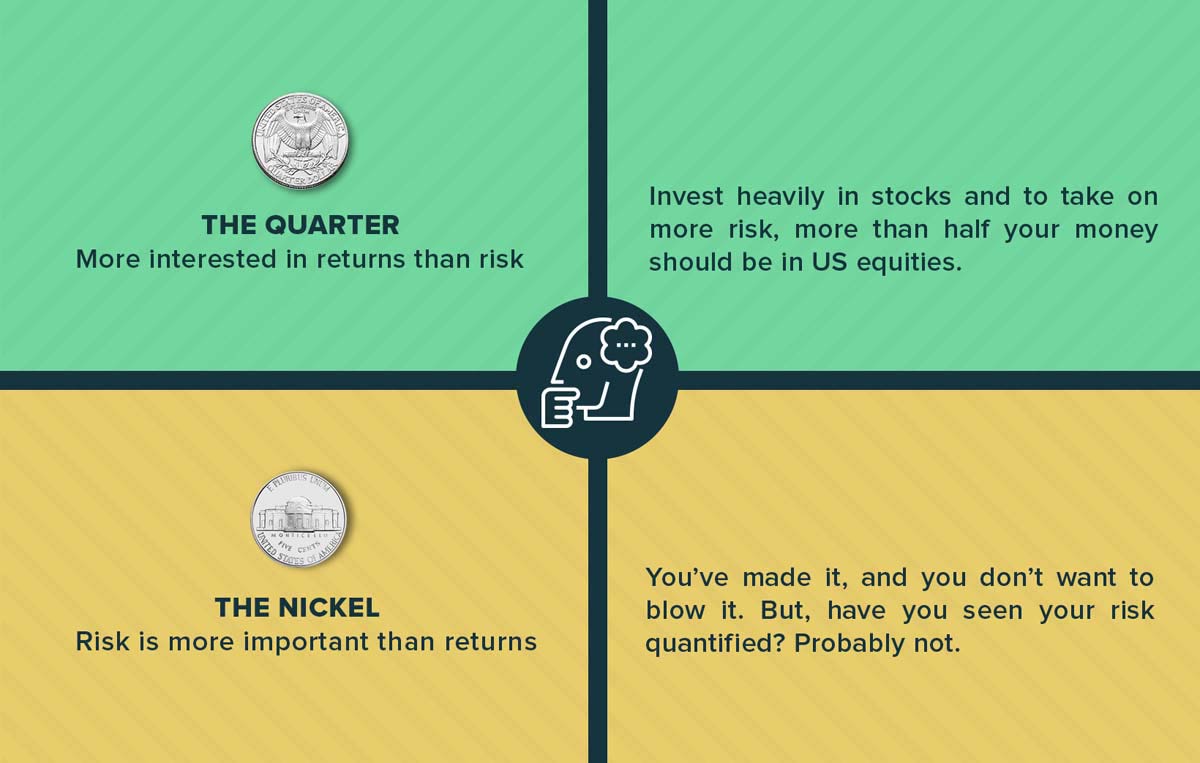3 Tips to Lower Your Portfolio Risk
How much do you think about the degree of risk in your portfolio? It's probably not enough. Here's how to think about risk and make portfolio adjustments to increase your odds of success.


“What’s your risk tolerance?”
If you have an investment adviser, you’ve probably been asked to rate your risk tolerance from one to 10. Or maybe you’ve been questioned about what your actions will be during the next market crash: Will you panic and sell or buy more?
I don’t know many investors self-aware enough to admit they will indeed engage in panic selling. Likewise, most investors don’t sit around with a pile of cash waiting for a market crash — the last crash was in 2008, so those investors have been waiting a long time. Besides, what did you do during the depths of 2008? Regardless, you’re now 11 years older and in a different place. Evaluating risk tolerance with simple abstract questions is not useful.
From just $107.88 $24.99 for Kiplinger Personal Finance
Become a smarter, better informed investor. Subscribe from just $107.88 $24.99, plus get up to 4 Special Issues

Sign up for Kiplinger’s Free Newsletters
Profit and prosper with the best of expert advice on investing, taxes, retirement, personal finance and more - straight to your e-mail.
Profit and prosper with the best of expert advice - straight to your e-mail.
Risk is powerful, but most of us are more accustomed to thinking about returns. Of course returns matter. But we can’t judge our returns without understanding the risk we have taken. Unfortunately, most people don’t have the slightest understanding of risk.
To Test Yourself, Flip a Coin
Here’s my test to start thinking about risk. Imagine all of your money stacked in bills on the desk in front of you. Now you are now looking at the largest stack of bills you have ever seen. We will play a game to determine how your money does over the next 12 months. Your job is to choose between picking up one of two coins: a nickel and a quarter.
If you choose the nickel, go ahead and flip it in the air. If it lands on heads you will be up 5%. However you will be down 5% if it lands on tails.
The stakes change if you choose the quarter. If it lands on heads, you will be up an impressive 25%. And tails? Well, you’ll be down 25%.
With all of your money on the line, which coin do you pick up? And more importantly, what does this tell us?

If you chose the nickel you are indicating that at this point in life, risk is more important to you than returns. You are in a good financial position, and you don’t want to blow it. If you are like most people, you can likely tell me your returns year to date. But if I ask you, “What is your risk?” You don’t have the foggiest idea.
If you place $100 in your bank account you will likely have between $100 and $103 a year from now. Money in the bank is low risk with a narrow range of outcomes. But if you place $100 in the S&P 500, a year from now it’s likely you’ll have between $65 and $150. U.S. stocks are much riskier than your local bank.
Risk is best understood as your range of outcomes. You cannot choose your future returns. But you can position your portfolio for a narrower range of outcomes. You can choose the nickel, the quarter or maybe a dime.
Practical Ways to Diversify Your Portfolio Against Risk
A range of outcomes is a choice that we, as investors, make. If you care more about risk and have more than half of your money in U.S. equities, you can likely lower your risk and decrease your range of outcomes. How? Diversification. Diversification is the process of owning things that will behave differently from the rest of your assets. Here’s how:
- Increase your weighting in international and emerging market stocks. No one knows how these markets will perform going forward, but they are likely to behave differently from U.S. stocks. Try VEA for international stocks and VWO for emerging market stocks.
- Buy some international bonds, denominated in international currencies. Try BWX for this. If the U.S. dollar depreciates, these bonds may do well.
- Buy some gold and commodities, which have historically had low correlation to U.S. stocks. Try GLDM for gold and PDBC for commodities. Beware that many commodity ETFs will deliver a Schedule K-1 tax form at tax time. PDBC, however, avoids this.
It’s hard to predict the future. It is much easier to add a diverse set of assets to your portfolio. Above all, be prudent. Don’t go overboard, but do go forward. Proper diversification can reduce your risk and range of outcomes without impacting your expected return.
Profit and prosper with the best of Kiplinger's advice on investing, taxes, retirement, personal finance and much more. Delivered daily. Enter your email in the box and click Sign Me Up.

Randy Kurtz, RIA, CFP®, is a nationally recognized expert on risk. Challenging the financial industry's status quo for over a decade, Kurtz feels the standard Wall Street portfolio comes with far more risk than clients realize. He created a method of investing that aims to lower excess risk taken in client portfolios, without reducing expected return. His goal is to transform the industry by turning the client-adviser relationship from a return-centered conversation to a risk-centered one.
-
 CD Maturing Soon? Here's What to Do Next
CD Maturing Soon? Here's What to Do NextThese strategies of what to do when you have a CD maturing soon will have you maximizing returns even with rate cuts.
-
 How to Make 2026 Your Best Year Yet for Retirement Savings
How to Make 2026 Your Best Year Yet for Retirement SavingsMake 2026 the year you stop coasting and start supercharging your retirement savings.
-
 You Saved for Retirement: 4 Pressing FAQs Now
You Saved for Retirement: 4 Pressing FAQs NowSaving for retirement is just one step. Now, you have to figure out how to spend and maintain funds. Here are four frequently asked questions at this stage.
-
 I'm a Financial Planning Pro: This Is How You Can Stop These 5 Risks From Wrecking Your Retirement
I'm a Financial Planning Pro: This Is How You Can Stop These 5 Risks From Wrecking Your RetirementYour retirement could be jeopardized if you ignore the risks you'll face later in life. From inflation to market volatility, here's what to prepare for.
-
 Are You Hesitating to Spend Money You've Spent Years Saving? Here's How to Get Over It, From a Financial Adviser
Are You Hesitating to Spend Money You've Spent Years Saving? Here's How to Get Over It, From a Financial AdviserEven when your financial plan says you're ready for a big move, it's normal to hesitate — but haven't you earned the right to trust your plan (and yourself)?
-
 Time to Close the Books on 2025: Don't Start the New Year Without First Making These Money Moves
Time to Close the Books on 2025: Don't Start the New Year Without First Making These Money MovesAs 2025 draws to a close, take time to review your finances, maximize tax efficiency and align your goals for 2026 with the changing financial landscape.
-
 Is Fear Blocking Your Desire to Retire Abroad? What to Know to Turn Fear Into Freedom
Is Fear Blocking Your Desire to Retire Abroad? What to Know to Turn Fear Into FreedomCareful planning encompassing location, income, health care and visa paperwork can make it all manageable. A financial planner lays it all out.
-
 How to Master the Retirement Income Trinity: Cash Flow, Longevity Risk and Tax Efficiency
How to Master the Retirement Income Trinity: Cash Flow, Longevity Risk and Tax EfficiencyRetirement income planning is essential for your peace of mind — it can help you maintain your lifestyle and ease your worries that you'll run out of money.
-
 I'm an Insurance Expert: Sure, There's Always Tomorrow to Report Your Claim, But Procrastination Could Cost You
I'm an Insurance Expert: Sure, There's Always Tomorrow to Report Your Claim, But Procrastination Could Cost YouThe longer you wait to file an insurance claim, the bigger the problem could get — and the more leverage you're giving your insurer to deny it.
-
 Could a Cash Balance Plan Be Your Key to a Wealthy Retirement?
Could a Cash Balance Plan Be Your Key to a Wealthy Retirement?Cash balance plans have plenty of benefits for small-business owners. For starters, they can supercharge retirement savings and slash taxes. Should you opt in?
-
 7 Retirement Planning Trends in 2025: What They Mean for Your Wealth in 2026
7 Retirement Planning Trends in 2025: What They Mean for Your Wealth in 2026From government shutdowns to market swings, the past 12 months have been nothing if not eventful. The key trends can help you improve your own financial plan.